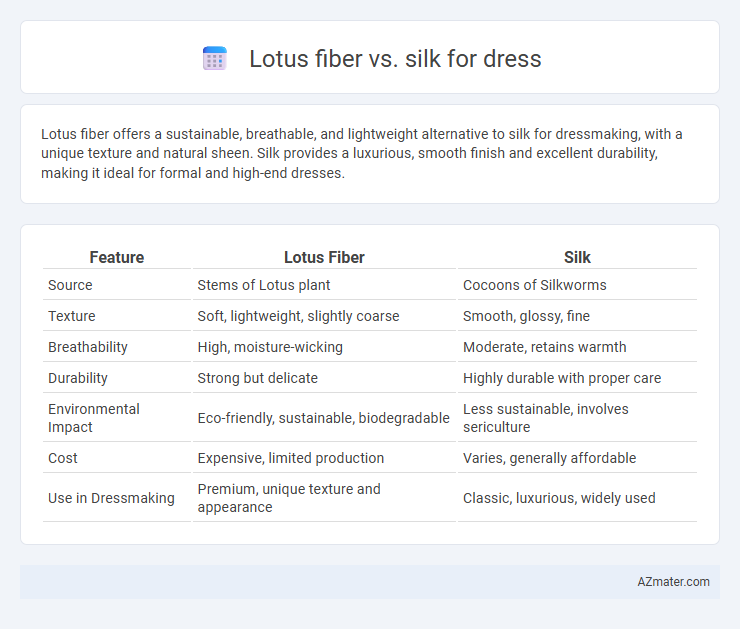Lotus fiber offers a sustainable, breathable, and lightweight alternative to silk for dressmaking, with a unique texture and natural sheen. Silk provides a luxurious, smooth finish and excellent durability, making it ideal for formal and high-end dresses.
Table of Comparison
| Feature | Lotus Fiber | Silk |
|---|---|---|
| Source | Stems of Lotus plant | Cocoons of Silkworms |
| Texture | Soft, lightweight, slightly coarse | Smooth, glossy, fine |
| Breathability | High, moisture-wicking | Moderate, retains warmth |
| Durability | Strong but delicate | Highly durable with proper care |
| Environmental Impact | Eco-friendly, sustainable, biodegradable | Less sustainable, involves sericulture |
| Cost | Expensive, limited production | Varies, generally affordable |
| Use in Dressmaking | Premium, unique texture and appearance | Classic, luxurious, widely used |
Introduction to Lotus Fiber and Silk
Lotus fiber, derived from the stalks of lotus plants, is a rare and sustainable textile known for its lightweight, breathable, and hypoallergenic qualities, making it ideal for luxurious and eco-friendly dresses. Silk, produced from silkworm cocoons, is a classic natural fiber celebrated for its smooth texture, natural sheen, and excellent draping ability, commonly used in high-end fashion. While both fibers offer unique benefits, lotus fiber stands out for its environmental sustainability, whereas silk remains a symbol of timeless elegance and softness in dressmaking.
Origins and Production Methods
Lotus fiber originates from the stems of lotus plants, primarily harvested in Thailand and Myanmar, where fibers are manually extracted through a labor-intensive process involving cutting, soaking, and twisting. Silk production begins with silkworm cultivation in regions like China and India, where cocoons are harvested and carefully boiled to extract continuous silk threads. Both fibers offer unique textures, with lotus fiber being eco-friendly and handcrafted, while silk relies on a centuries-old sericulture industry combining natural protein threads and skilled reeling techniques.
Texture and Feel
Lotus fiber offers a unique texture characterized by its coarse, slightly rough surface and natural matte finish, providing a rustic and eco-friendly feel that becomes softer with use. Silk boasts a smooth, lustrous texture with a luxurious, lightweight, and silky-soft touch that drapes elegantly on the body. While lotus fiber dress fabrics emphasize durability and breathability, silk prioritizes softness and sheen, making each ideal for distinct fashion aesthetics.
Durability and Longevity
Lotus fiber offers exceptional durability due to its natural cellulose structure, making it resistant to wear and tear compared to delicate silk fibers. Silk, while renowned for its softness and sheen, is prone to weakening over time with exposure to moisture and sunlight, reducing its longevity. Choosing lotus fiber for dresses ensures sustained fabric strength and longer-lasting garments, ideal for those prioritizing durability.
Sustainability and Eco-Friendliness
Lotus fiber, derived from the stems of lotus plants, offers a highly sustainable alternative to silk due to its biodegradable nature and minimal water usage in cultivation. Silk production involves extensive mulberry cultivation and energy-intensive processes, often causing environmental strain and ethical concerns related to silkworm harvesting. Choosing lotus fiber for dresses supports eco-friendly fashion by reducing carbon footprint and promoting renewable resource use.
Breathability and Comfort
Lotus fiber offers exceptional breathability due to its natural porous structure, making it ideal for hot and humid climates, while silk provides moderate breathability with a smooth, soft texture that enhances comfort. Lotus fiber dresses maintain dryness and air circulation, reducing moisture buildup, whereas silk excels in temperature regulation with a lightweight feel that adapts to body heat. Both fabrics deliver comfort, but lotus fiber stands out in moisture-wicking and eco-friendliness compared to the luxurious softness of silk.
Aesthetic Appeal and Luxury
Lotus fiber offers a unique matte finish with a naturally earthy texture, creating an understated and eco-friendly aesthetic that appeals to niche luxury markets. Silk boasts a lustrous sheen and smooth, flowing drape that epitomizes classic elegance and opulence in high-end fashion. Both fibers provide distinct luxury experiences, with lotus fiber highlighting sustainability and artisanal craftsmanship, while silk emphasizes timeless glamour and softness.
Care and Maintenance Requirements
Lotus fiber dresses require gentle hand washing in cold water with mild detergent to preserve their delicate texture and natural sheen, avoiding machine washing and harsh chemicals. Silk dresses demand low-temperature hand washing or dry cleaning to maintain their smooth, lustrous finish, with care taken to prevent exposure to direct sunlight and moisture to avoid fabric damage. Both materials benefit from air drying away from direct heat and storing in breathable garment bags to extend garment longevity.
Price Comparison
Lotus fiber dresses typically cost significantly more than silk due to the labor-intensive process of extracting fibers from lotus stems. Silk remains more affordable and widely available, making it a common choice for everyday wear. The rarity and sustainability of lotus fiber contribute to its premium price point in the luxury fashion market.
Conclusion: Choosing the Best Fabric for Dresses
Lotus fiber offers exceptional breathability, sustainability, and a unique texture ideal for eco-friendly, lightweight dresses, while silk provides unmatched softness, luxurious sheen, and durability suited for elegant, formal wear. For those prioritizing environmental impact and natural aesthetics, lotus fiber is the best choice, whereas silk excels in premium fashion requiring smooth drape and vibrant luster. Selecting between lotus fiber and silk depends on the desired balance of comfort, sustainability, and sophistication in dress fabric.

Infographic: Lotus fiber vs Silk for Dress
 azmater.com
azmater.com